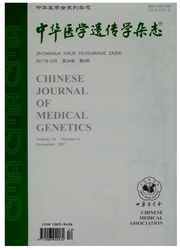

 中文摘要:
中文摘要:
目的鉴定一个先天性无虹膜合并白内障家系的致病是否与PAX6基因突变有关。方法提取该家系全部12名存活成员和96名正常人外周血白细胞DNA,PCR扩增PAX6基因的第4~13编码外显子及侧翼内含子剪切区域,通过直接测序比较家系患者与正常人序列差异以确定致病突变。结果对PAX6基因序列分析结果显示,该家系3例患者中均存在一个无义突变,而在正常人和家系中非受累成员中则未发现。无义突变位于PAX6基因第10外显子1143位核苷酸c.1143C〉T,突变导致精氨酸替换为终止密码(R261X)。结论PAX6基因突变R261X是中国人先天性无虹膜合并白内障的致病突变。
 英文摘要:
英文摘要:
Objeetive To identify the mutation in the PAX6 gene in a family with congenital aniridia and cataract. Methods Total genomic DNA was extracted from peripheral blood leukocytes of 12 family members including three living affected members and 96 unrelated healthy controls. The coding exons 4-13 of the PAX6 gene with intronic flanking sequences were amplified by polymerase chain reaction (PCR). By comparing sequences of the affected members with that of normal individuals, the disease-causing mutation was detected by direct DNA sequencing. Results A PAX6 mutation was identified in the 3 patients, which did not exist in the unaffected members and unrelated healthy individuals. The nonsense mutation of C to T was detected at the nucleotide 1143, which converted the Arg codon (CGA) to a stop codon(TGA) (R261X) in exon 10. Conclusion The mutation (R261X) detected in the present study is considered to result in the occurrence of congenital aniridia and cataract in the Chinese family.
 同期刊论文项目
同期刊论文项目
 同项目期刊论文
同项目期刊论文
 An association study of SERPING1 gene and age-related macular degeneration in a Han Chinese populati
An association study of SERPING1 gene and age-related macular degeneration in a Han Chinese populati Association study of genetic variants in eight genes/loci with type 2 diabetes in a Han Chinese popu
Association study of genetic variants in eight genes/loci with type 2 diabetes in a Han Chinese popu 期刊信息
期刊信息
